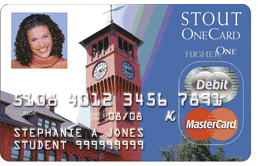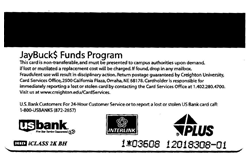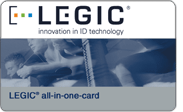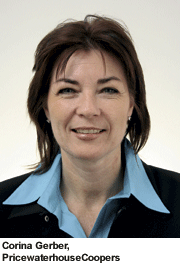 Frequently, campus administrators struggle with the decision to add a banking partner or other off-campus functionality to their campus card. How will it affect spending on campus? Will it cost me more or will it generate revenue? What will happen to our card’s stored value accounts?
Frequently, campus administrators struggle with the decision to add a banking partner or other off-campus functionality to their campus card. How will it affect spending on campus? Will it cost me more or will it generate revenue? What will happen to our card’s stored value accounts?
According to several colleges that have chosen to add banking and other off-campus functionality to their campus ID cards, the advantages for off-campus card use far exceed the disadvantages. In the end, these colleges agree that students love the extra choices available to them and that pays off in the long run.
“One of the questions we get asked frequently is: ‘Will adding a banking partnership reduce the dollars being spent in the campus stored value accounts?’” said Whitney Bright, vice president and general manager for Campus Banking with U.S. Bank. “Experience has shown that by adding a banking partner, students see their card as more of a financial tool. Most of our campuses haven’t seen a decrease in on-campus spending. In fact, it can have an opposite effect, because students end up using the card more often for all kinds of functions.”
“If they really analyze it, they’ll find that a banking partnership is a greater value to students and a greater financial value to the campus. But they must have an effective communications plan so students understand the difference between their on-campus account and their bank account … and where they can use those different accounts,” she said.
Sean Glass with Higher One agrees. His company, a provider of refund management and banking services for colleges and universities, has found that “with our ID card clients, the banking and refund management program helps to increase the amount of on-campus spending through our Campus Autoload feature.”
 The program “lets students choose to have money automatically transferred from their OneAccount checking account whenever their on-campus flex account drops below a certain level,” says Mr. Glass. “One of our earliest clients, University of Wisconsin-Stout, (found) that adding our service improved the economics of their previous flex account system.”
The program “lets students choose to have money automatically transferred from their OneAccount checking account whenever their on-campus flex account drops below a certain level,” says Mr. Glass. “One of our earliest clients, University of Wisconsin-Stout, (found) that adding our service improved the economics of their previous flex account system.”
Blackboard study quantifies this ‘growth for all’ phenomenom
What has been the impact on on-campus spending levels via the card following the launch of Blackboard’s BbOne off-campus program at client institutions? CR80News posed this question to Pedro Marzo, Director, of BbOne.
“This is the number one question we get asked by prospect clients so two years ago we decided to conduct a study among our clients to find out conclusively. We found out that on-campus spending increased on average 25% over three years,” said Mr. Marzo.
“For every dollar that is deposited into the flex account, about 2/3 gets spent on-campus, and only 1/3 goes to off-campus merchants,” he continues. “In other words, the size of the pie gets bigger, and often on-campus locations keep the biggest slice.”
The study showed that deposit levels increased as well … “on average 85% over three years,” according to Mr. Marzo. “The increase was significantly higher at institutions with brand new deployments and closer to 20% at schools with mature card programs.”
 Creighton University sees overall growth through the banking addition
Creighton University sees overall growth through the banking addition
Omaha, Neb.-based Creighton’s banking relationship with U.S. Bank “is a win/win/win for all. We get help providing goods and services to our patrons without having to capitalize from a shrinking budget,” said Brenda Hovden, Creighton’s director of card services. “We’re not any different from any private institution. We come back with all these ideas, but our budgets just don’t have the ability to keep up. U.S. Bank gives us marketing opportunities and support. From our experience there are definitely benefits to having both a banking relationship and an off-campus program.”
She added: “Our community members are in need of financial transaction services beyond our campus fringe and that’s what the bank is looking to provide. The student or employee, the university, and the financial institution are looking for a long-term relationship that continues to be mutually beneficial. With U.S. Bank as our partner, Creighton University community members have access to personal financial coaches and local services.”
Creighton’s off-campus program “creates for merchants’ opportunities to reach our campus population,” she said. “One benefit is it offers our patrons the flexibility to choose from multiple payment methods. It’s this same flexibility that boosts our participation levels in both the number and balances carried in our JayBuck$ (declining balance) program.”
Does the banking functionality take away from the off campus merchant program? “Definitely not,” said Ms. Hovden. “While they both offer a mechanism to make off-campus transactions and the ability to monitor and budget student spending they also have different features and functionalities that we feel complement one another. With U.S. Bank’s Student or Workplace Banking our community members also have access to an array of services whose borders stretch beyond our campus fringe or functionality. We’re simply extending to our community members an opportunity to access those services using our ID Card.”
The 7,000 student-strong Creighton, with another 2,500 faculty and staff, uses BB One from Blackboard and currently has about six outside vendors, she said.
The student card can double as an ATM and PIN-based debit card. “It doesn’t have a Visa logo and you cannot perform signature-based transactions, in other words, no credit capabilities. So if the card is lost, it becomes ineffective immediately unless that person has your PIN number,” added Ms. Hovden.
Wisconsin campus finds similar growth with off-campus declining balance program
Having an off-campus program at the University of Wisconsin-Stevens Point has been a blessing since the school’s student union is undergoing construction. “Students still have increased opportunities for their dining and other needs,” said Jerome B. Lineberger, associate director University Centers. “Actually, they currently complement each other very effectively.”
He added: “There are cost and service level benefits to each program. In the long term, as payment media technologies merge and become more transparent to the user, it may become less of an issue.”
The university started its off campus program about five years ago, through Student Advantage. “When they were purchased by Blackboard, it was rolled into a Blackboard off-campus program,” said Mr. Lineberger.
He said when the university first implemented its off-campus program, the concern was “that we might cannibalize our on-campus sales. The college uses what it calls “PointCash,” a cash equivalency not tied to any meal plan. The college’s foodservice operator was concerned that all this PointCash money would go to the off campus merchants. “But our deposits went up, not down,” he said.
The university currently has about 15 off-campus merchants to service its 8,200 students. Merchants include food, laundry and dry cleaners.
Conclusion
The concerns are out there and campus card administrators will almost certainly face the questions when a new payment option is added to a card program. Will an off-campus program impact on-campus spending? Will a banking partnership impact on-campus and/or off-campus declining balance spending? Are we cannibalizing our revenues? The campuses and vendors interviewed for this article seem to agree that more options make for better usage, and better usage means more spending across locations and payment vehicles.
Perhaps Mr. Glass sums it up best when he stresses that you are not replacing the on-campus program when you add a banking partner. “When the school didn’t have banking on the campus card, students still had bank accounts … so adding banking won’t change how they access their money, it just makes it more convenient that they can do it all through one card.”
Mr. Marzo sums it up from the BbOne perspective, “perhaps the best evidence in favor of off-campus programs is that in all the years we’ve been managing (them) we’ve never seen a client re-evaluate their decision to go off-campus.”
University of Washington selected CBORD’s Foodservice Suite to serve its 40,000 students and 4,700 board plan participants. The school will make use of modules for “menu management, inventory management (including PDA-enabled data entry for onsite inventory tracking), CBORD’s nutrient database, nutritional accounting, event management, and interfaces for order transmissions to outside vendors, point-of-sale terminals, and accounts payable.”
CBORD welcomes the University of Washington
University purchases Foodservice Suite to improve margins and efficiency
Ithaca, New York: The CBORD Group, Inc. is pleased to announce that the University of Washington recently selected the company as its foodservice technology provider. The university purchased Foodservice Suite®, a modular software package designed to improve margins and increase customer and employee satisfaction by automating campus foodservice operations.
The University of Washington’s use of Foodservice Suite includes modules for menu management, inventory management (including PDA-enabled data entry for onsite inventory tracking), CBORD’s nutrient database, nutritional accounting, event management, and interfaces for order transmissions to outside vendors, point-of-sale terminals, and accounts payable. The school is also a user of CBORD’s Odyssey HMS™ housing management system, including its Judicial module.
The University of Washington was honored in 2003 by the National Association of College & University Food Services (NACUFS) with the Loyal E. Horton award in recognition of its eclectic and innovative food court, the Husky Den.
“We looked for a company that offered modern solutions for growth and sustainability to support our diverse lines of business, as well as one that could provide the service and support needed to effectively train users and implement the system,” says Anita Bowers, Assistant Director of Housing and Food Services at the University of Washington. “We found CBORD and its staff to best fit our needs.”
“The University of Washington has long been respected in the college and university foodservice industry for its innovations in campus dining,” says Peg Lacey, National Market Manager, Colleges & Universities, The CBORD Group, Inc. “We are very pleased to assist the university in further refining its already impressive operations.”
The University of Washington currently enrolls 40,000 students. It has a residence hall population of 4,900, with 4,700 students on board plans.
About The CBORD Group
The CBORD Group serves colleges and universities, corporations, healthcare facilities, chain restaurants, supermarkets, and a host of other market segments. CBORD’s products are used in foodservice, catering, nutrition services, online ordering, meal plans, campus ID card privilege control, access control, electronic security, housing services, and other institution-wide activities. The CBORD Group serves more than 5,000 clients in the U.S., Canada, Europe, South Africa, the Middle East, New Zealand, and Australia, including more than 850 colleges and universities.
 By Andy Williams, Contributing Editor
By Andy Williams, Contributing Editor
When PricewaterhouseCoopers went from 13 different buildings down to one at its Zurich, Switzerland office, many of its 1,200 employees were using different ID cards providing only limited uses. So why not switch to one multi-function card?
That’s what the company went searching for. “We’ve always tried to look for state-of-the art systems and we found this card,” explains Corina Gerber, facility management, senior manager, for PricewaterhouseCoopers Switzerland (PwC).
This card Ms. Gerber refers to contains a chip manufactured by fellow Switzerland-based LEGIC Identsystems that handles everything the company needs with room for expansion.
 Called an “all-in-one” card, it’s not new. Actually, it has been around about 10 years, said Bob Fee, general manager, Business Unit, for LEGIC in North America. But with the demand for more applications on one card, a multi-function type card is starting to come into its own.
Called an “all-in-one” card, it’s not new. Actually, it has been around about 10 years, said Bob Fee, general manager, Business Unit, for LEGIC in North America. But with the demand for more applications on one card, a multi-function type card is starting to come into its own.
PwC’s applications include building access, print management, an e-purse for cafeteria usage, garage and elevator access, and more, said Ms. Gerber.
For the time being just the Zurich office has the new card. “We moved into the new building about a year ago. Before that we had 13 different buildings. Just from a logistics (point of view) it was not working out correctly. We all moved under one roof in November, 2005 and had to design our own solutions for our cards,” said Ms. Gerber.
Secure document management provides a key application
PwC is a professional services firm best known for its auditing and accounting capabilities. One of the biggest demands the company had for its card is what Ms. Gerber calls “follow me” or “follow&secure” printing. Obviously a company dealing with tax returns and other sensitive data doesn’t want documents spit out by one of the company’s 60-plus multi-function printers/faxes/scanners just lying around until the person who sent the documents to the printer shows up to claim them.
“Secure means you have to physically go to the machine and, using your badge, release your documents,” said Ms. Gerber. “You always have things you don’t want lying around. You have the whole Human Resources department that prints out things such as salary schedules. This was one functionality we needed.”
With “follow&secure”, the job is sent to the printer, but it’s not printed until the document’s owner shows up at one of the company printers and flashes his card to the machine. That unlocks the printer and the job, which has been stored in a queue. Once the printing is finished, the person puts in his card again, which locks the printer.
The “follow” aspect of the solution is that the print job can follow wherever you happen to be.
“We have about 62 machines in the building and I can use any of these machines. I have my office on the first floor and I may have meeting on the fifth floor. That makes it very convenient. I don’t have to go to a particular printer. I can use the one on the fifth floor,” said Ms. Gerber.
“It’s also, a cost factor,” she added. “We used to have printers and copying machines. Printers aren’t that expensive but maintenance of copiers can be quite high. With the multi-function devices, costs are quite lower. We can print, scan, copy, and fax. Scanning is really great. You go there with your badge and once the device knows it is you, you put in the papers to be scanned and within one minute it’s in your mailbox.”
Access control via contactless and biometrics
Physical access control is another key component of the card. During normal business hours, only the employee’s ID badge is needed to gain access. “But after hours and on weekends, we go to biometrics,” specifically a fingerprint, said Ms. Gerber. The fingerprint template, added Mr. Fee, is stored on the 1 kb contactless chip.
 Employees have to use a separate entrance in this case, where they have to produce both their badge and their finger. They then enter through a turnstile-like door that allows just one person in at a time. That, of course, prevents one employee from letting in several others with his badge and fingerprint.
Employees have to use a separate entrance in this case, where they have to produce both their badge and their finger. They then enter through a turnstile-like door that allows just one person in at a time. That, of course, prevents one employee from letting in several others with his badge and fingerprint.
Nothing’s perfect, however, so PwC also has 24-hour security in place as well, she said.
“When biometrics was first introduced, we thought maybe employees wouldn’t want to give us their fingerprint. But it’s just to gain access and it only covers five points. It’s not like the fingerprints police take. It’s the lowest type of fingerprint,” she added. “So nearly all of our employees gave us their fingerprint.”
The smoothness of the transition to the new system was brought about by “all the communication we did with our employees before we moved into the new building. We showed them what we intended to do with biometrics and how it works and how the multifunction devices would work,” she said.
PwC has offices in 149 countries; and some 140,000 employees. “In Switzerland, we have about 2,500 employees in 14 offices and 1,200 employees at the Zurich office,” she said.
Different vendors, different applications, but a single card …
“What we’re trying to make people understand,” said Mr. Fee, “is that different applications from different vendors doing different things can be stored on the card and be totally independent of each other. We have 50,000 customers. About half of them use more than just one application, usually two or three on average,” he added. The applications, like PwC, include access control, cashless payment, time and attendance, and the follow and secure print concept.
“About five Legic partners offer the ‘follow me print’ application. This particular application is being sought after more and more,” he said.
What PwC is utilizing on its all-in-one card is just the tip of the iceberg. German automaker BMW, serviced by LEGIC, “has 17 applications on their ID card. Airbus has 12,” said Mr. Fee. “They’re actually saving money because they’re using one card and it gives them more flexibility.”
The 13.56 frequency LEGIC contactless smart card uses encryption in the transmission. Data from the different vendors are encrypted from reader to the card and also on the card itself. “It provides a higher level of security. If a person loses the card there is nothing that can be accessed,” said Mr. Fee.
In fact, added Ms. Gerber, anyone finding a lost card won’t even know that it’s from PwC. There is a separate company name (Interlock) on the back of the card, and a telephone number. People can use that as a means of returning the card.
“We chose the name of the company which makes the card,” she added. “It’s a card maker here in Switzerland that we use.” When the card is lost, she said, it’s locked out of the system, but the money in the e-purse portion of the card is gone. Employees can load about 100 Swiss francs on the card that is usable in the company’s cafeterias or vending machines.
Originally, PwC had an ID card with no functions on it. “It was just a card that showed you were working at PricewaterhouseCoopers,” said Ms. Gerber.
While the Zurich office was the first with this type of card, other PwC offices are starting to come on line. “Geneva is starting up with the multi-function machines. We have to provide a card so an employee in Geneva, when he comes to the Zurich office, can still use the same card. Geneva is the first that has started doing this, but we’re working slowly with other (PwC) locations,” she said.
However, these cards carry only building access capabilities and aren’t yet all-in-one cards, she added.
From Zurich to the PwC world?
Ms. Gerber estimates that each card produced by PwC costs about 10 Swiss francs, but that includes the cost of the machine as well. “We produce our own cards for obvious security reasons,” she added.
Added Mr. Fee about the all-in-one card installation: “We relied on our partner network who did the installation and integration. We acted as a consultant and helped them understand how best to use the technology. We provided the oversight, the RF module and the transponder.”
He cited the PwC installation as “an excellent example of how an organization can utilize an all-in-one card. It reduces costs, increases security and gives them the flexibility to do more down the road … to use technology to enhance the organization. They can easily add or remove applications a year from now or five years from now. We’ve had customers using the technology for the last 15 years. It’s very secure and very flexible.”
 Keeping track of the bad cards–those that were printed but never issued–is just as important as tracking the good cards when managing your ID card system.
Keeping track of the bad cards–those that were printed but never issued–is just as important as tracking the good cards when managing your ID card system.
For John Ekers, Fargo Electronics’ director of product marketing for software and services, it has become something of an evangelization issue.
“One of the things we’ve been trying to promote, which comes from working with security bureaus, is that it’s not just about your cards, but about your duplicates as well, your bad cards and how you are managing those,” said Mr. Ekers.
 “…particularly in the ID market with desktop printers, you see a huge gap. No one is managing the bad cards, the ones that had to be remade,” he stresses. “Not many have software in place to tell you we made four copies of Jane’s ID badge and the fifth is what we sent out.”
“…particularly in the ID market with desktop printers, you see a huge gap. No one is managing the bad cards, the ones that had to be remade,” he stresses. “Not many have software in place to tell you we made four copies of Jane’s ID badge and the fifth is what we sent out.”
What’s needed is something that will help organizations to do a reconciliation to match bad cards against the inventory and produce an audit trail. “The bad cards don’t necessarily have to be kept on file, but a supervisor needs to look at them, check them off (that they actually reviewed them) and then the cards can be destroyed,” said Mr. Ekers.
It’s all about hardening your security. The card may not have been encoded yet, but the picture is still there, the name is on the card and it could still be used fraudulently.
Fargo and others have tools that can secure the issuance process. “We’re trying to manage the issuance of both good cards and bad cards,” explained Mr. Ekers.
A recent presentation at a National Association of Campus Card Users (NACCU) conference on the issuance process ended, “with most of (the 40 college attendees) wanting to get back to their offices as soon as possible,” said Mr. Ekers. “These were people who initially felt their offices were pretty secure,” he said. “You need to know who has access to your card issuance system. Can someone come in over the weekend and produce fraudulent cards? And what is your liability if that happens? Fear drives a lot of this.”
If you’re providing a system to manage access, but you’re not managing the security of the issuance process, you could still be liable for any breakdown that occurs, he said. For example, someone could print out a fraudulent card that allows him to gain access to a secure building.
One preventative measure organizations can take is to utilize a tool that can lock down their printers. “If you have an application running on your PC, the only way the printer will work is if you present the printer password. That’s more widely accepted in the education market. In a lot of cases,” said Mr. Ekers, “you have students doing the badging process. At least over the weekend no one can come in and access the printer.”
Complementing that system, he added, would be a notification application. “An individual who comes in over the weekend who wanted to print badges and if the printer wasn’t locked up, the printer would send out a message over the network or cell phone and let the manager know that someone is trying to print something,” said Mr. Ekers.
Another possible security gap is the data itself that’s used to print the badges. “We recommend that you don’t maintain that data any longer than you need it. If you look at Visa or MasterCard, they’re not allowed to maintain account information for more than seven days. You don’t have to maintain a local database,” said Mr. Ekers.
Computer advancements have also led to more security holes. The simple USB port provides quick access to data on the computer. “A lot of corporations are not buying computers with USB ports,” he said.
Even if you don’t have the means to implement a sophisticated issuance security and card inventory system, “you can at least have an Excel spreadsheet where you log in the number of cards, cards you’ve printed, and so forth,” said Mr. Ekers. “You really need to manage that inventory.” Or, you could go low-tech with a simple pencil and paper method, he added.
“So many colleges today seem to be overwhelmed with operational requirements. Historically, they’ve let a lot of these things go just to get the cards out the door. But I think they’re starting to understand that there’s a lot more at stake,” said Mr. Ekers.

